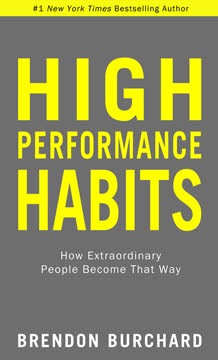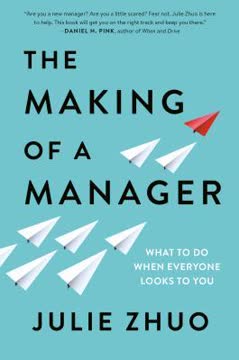Key Takeaways
1. Embrace the Productivity Ninja mindset for enhanced work efficiency
A Ninja overcomes stress at work by being prepared and practising ruthlessness in their approach to their work.
Zen-like calm. Develop a state of mental tranquility by trusting your systems and lowering expectations. Recognize that you'll never get everything done, but focus on doing as much as humanly possible.
Ruthlessness. Practice saying "no" to yourself and others, protecting your attention from interruptions. Remember that most information is close to worthless, so be selective about what demands your focus.
Weapon-savvy. Choose and master the right productivity tools, but don't get seduced by "productivity porn." Tools should assist your thinking and organizing, not replace the need for it.
2. Master attention management to overcome information overload
Time might be spent, but attention still needs to be paid.
Understand attention levels. Recognize three types of attention: proactive (fully focused), active (easily distracted), and inactive (limited brainpower). Schedule work based on these levels for optimal productivity.
Protect your attention. Implement strategies to minimize both internal and external distractions:
- Get new ideas off your mind quickly by capturing them
- Process email in batches rather than constantly checking
- Use "internet famines" to avoid temptation
- Practice "selective ignorance" by avoiding unnecessary information
Increase your attention. Boost your brain's performance through:
- Proper nutrition and hydration
- Regular physical exercise
- Meditation and mindfulness practices
- Strategic use of caffeine
3. Implement the CORD model for seamless workflow organization
Everything is out of their mind and stored inside a second brain they can trust to deal with it.
Capture and Collect. Gather all inputs, ideas, and commitments into designated collection points. Use tools like notebooks, apps, or in-trays to ensure nothing slips through the cracks.
Organize. Process collected items by asking key questions:
- Is there an action worth doing?
- Is it me who needs to do it next?
- What's the next physical action?
- Is there a project relating to this?
- Is there a deadline to capture?
Review. Regularly assess your systems and commitments through daily and weekly reviews. This ensures nothing falls through the cracks and keeps you aligned with your goals.
Do. Focus on completing actions efficiently, leveraging your organized system to make informed decisions about what to work on next.
4. Revolutionize email management with the "inbox zero" approach
For every 800 emails you have, there will be around 20 there that will matter and 780 that can either be deleted, filed or at worst, very quickly replied to in just a few seconds.
Change your mindset. View your inbox as a temporary holding area, not a to-do list. Process emails decisively, moving them to appropriate action folders or reference systems.
Implement a system. Create three processing folders:
- @Action: For emails requiring responses longer than two minutes
- @Read: For non-urgent, informational emails to review later
- @Waiting: For tracking emails awaiting responses from others
Practice regular processing. Aim to get your inbox to zero several times a day. Use the "two-minute rule" to immediately handle quick tasks, and ruthlessly delete or file non-essential emails.
5. Leverage checklists for consistent productivity and decision-making
Checklists give you confidence and reduce friction.
Weekly Checklist. Dedicate 1-2 hours each week for a comprehensive review:
- Get all inputs back to zero
- Update your second brain (review calendar, projects, and actions)
- Think ahead (generate new actions for projects)
- Get ready (prepare for the upcoming week)
- Ask reflective questions (focus on ruthlessness, resistance, health, and happiness)
Daily Checklist. Spend 5 minutes each morning to:
- Review your calendar
- Identify "big rocks" (important tasks)
- Anticipate resistance
- Plan attention management
- Consider dependencies
These checklists ensure consistent thinking and decision-making, reducing stress and increasing productivity.
6. Optimize meetings and project management for maximum impact
Time is money. And then some.
Rethink meetings. Before scheduling a meeting, consider alternatives:
- Email for coordination and idea gathering
- Conference calls for focused discussions
- Collaborative technologies for document editing
- Desk hijacking for quick, one-on-one conversations
Implement the 40-20-40 continuum. For necessary meetings:
- 40% preparation: Set clear objectives, plan the flow, and choose appropriate locations
- 20% execution: Manage pace, encourage participation, and steer towards decisions
- 40% follow-through: Ensure commitments are kept and actions are taken
Simplify project management. Use the five-milestone model:
- Establishment
- Underway
- Mid-way
- Completion
- Celebration
This approach provides structure without over-planning, allowing for agility and regular steering.
7. Cultivate habits that promote focus, momentum, and work-life balance
Doing what you love and loving what you do used to be seen as some kind of pipe dream. I would argue that as we firmly establish the information age, it's easier than ever to make this a reality.
Practice monotasking. Focus on one task at a time, avoiding the inefficient switching costs associated with multitasking. Use techniques like the Pomodoro method (25 minutes of focused work followed by a 5-minute break) to maintain concentration.
Batch similar tasks. Group related activities to minimize setup time and maximize efficiency. For example, handle all phone calls or email responses in dedicated blocks of time.
Implement "Power Hours." Schedule focused work sessions for your most important or challenging tasks. Protect this time from interruptions and distractions to make significant progress on key projects.
Pursue work you enjoy. Recognize that true productivity comes from engagement and passion. Continuously evaluate your work and seek opportunities that align with your interests and strengths. Don't be afraid to make changes that lead to greater fulfillment and, consequently, higher productivity.
Last updated:
FAQ
What's How to be a Productivity Ninja about?
- Focus on Productivity: The book emphasizes achieving more with less effort, focusing on effective productivity strategies rather than traditional time management.
- Ninja Mindset: It introduces the concept of the "Productivity Ninja," which embodies traits like Zen-like calm, ruthlessness, and agility to enhance productivity.
- CORD Model: The book presents the CORD Productivity Model, which consists of four key habits: Capture and Collect, Organize, Review, and Do, aimed at streamlining workflow.
Why should I read How to be a Productivity Ninja?
- Practical Techniques: The book offers actionable techniques that can be implemented immediately to improve productivity and reduce stress.
- Real-World Applications: It draws from the author's experiences working with various organizations, making the advice relatable and applicable to everyday work scenarios.
- Mindfulness and Clarity: It promotes a mindset of mindfulness, helping readers to manage their attention and focus effectively in a world of information overload.
What are the key takeaways of How to be a Productivity Ninja?
- Attention Management: Managing attention is more crucial than traditional time management, especially in today's fast-paced work environment.
- Capture and Collect: Emphasizes capturing all thoughts and tasks to clear mental clutter, allowing for better focus on current tasks.
- Organize and Review: Stresses the need for organizing tasks into actionable lists and regularly reviewing them to maintain clarity and control.
What is the CORD Productivity Model in How to be a Productivity Ninja?
- Four Key Habits: The CORD model consists of Capture and Collect, Organize, Review, and Do, which together create a strong workflow.
- Sequential Process: Each habit flows into the next, meaning effective capturing leads to better organization, which facilitates thorough reviewing and efficient doing.
- Strengthens Productivity: By mastering each step, individuals can enhance their productivity and reduce stress, creating a more manageable workload.
How does How to be a Productivity Ninja define a "Productivity Ninja"?
- Mindset of Calm: A Productivity Ninja maintains a Zen-like calm even amidst chaos, allowing for better decision-making and focus.
- Ruthlessness in Choices: They are ruthless in prioritizing tasks, focusing only on what adds the greatest impact to their work.
- Agility and Preparedness: A Ninja is agile, able to adapt to changing circumstances, and always prepared for challenges that may arise.
How can I manage my attention effectively according to How to be a Productivity Ninja?
- Proactive Attention: Identify when your attention is at its peak and schedule challenging tasks during these times for maximum productivity.
- Attention Levels: Categorize tasks into proactive, active, and inactive attention levels, allowing you to allocate your energy appropriately.
- Minimize Interruptions: Protect your attention from distractions by creating a work environment that minimizes interruptions to maintain focus on important tasks.
What is the significance of the Master Actions List in How to be a Productivity Ninja?
- Comprehensive Task Management: Serves as a central repository for all actionable tasks across various projects, preventing overwhelm.
- Dynamic and Flexible: It’s a living document that changes frequently, reflecting your current commitments and priorities.
- Clarity and Focus: By having a clear list of actions, you can focus on what needs to be done next without getting distracted by other thoughts.
How does How to be a Productivity Ninja suggest handling meetings?
- Reduce Unnecessary Meetings: Encourages avoiding non-essential meetings, suggesting alternatives like emails or collaborative tools.
- Effective Meeting Structure: Meetings should be well-structured with clear agendas and defined outcomes, using the 40–20–40 principle for preparation, meeting time, and follow-up.
- Follow-Up Actions: Ensuring that follow-up actions are clearly defined and communicated is crucial for accountability and maintaining momentum.
What are some techniques to overcome resistance as discussed in How to be a Productivity Ninja?
- Acknowledge Resistance: Recognizing and naming your resistance is the first step in overcoming it, allowing you to confront it directly.
- Create Momentum: Build momentum by starting with small, manageable tasks to reduce the power of resistance and encourage further action.
- Use Routines: Establishing routines can help distract resistance and create a flow state, minimizing its impact.
What are some practical techniques for managing email in How to be a Productivity Ninja?
- Inbox Zero Concept: Advocates for achieving "inbox zero," where all emails are processed and organized into actionable categories.
- Processing Folders: Suggests creating folders like @Action, @Read, and @Waiting to streamline email management and reduce clutter.
- Batch Processing: Recommends processing emails in batches rather than checking them constantly, which helps maintain focus and reduces distractions.
What is the importance of "Capture and Collect" in How to be a Productivity Ninja?
- Clearing Mental Clutter: Involves capturing all thoughts, tasks, and ideas to prevent them from becoming nagging distractions.
- Second Brain Concept: Encourages the use of a "second brain" to store and manage these captured items, allowing for better focus on current tasks.
- Stress Reduction: By capturing everything, individuals can alleviate stress and anxiety associated with forgetting tasks or ideas.
What are the best quotes from How to be a Productivity Ninja and what do they mean?
- "Being busy does not always mean real work.": Highlights the difference between mere busyness and actual productivity, urging readers to focus on meaningful work.
- "The mind is for having ideas, not for holding them.": Emphasizes the importance of capturing thoughts externally rather than trying to remember everything mentally.
- "We must be willing to get rid of the life we’ve planned so as to have the life that is waiting for us.": Encourages flexibility and adaptability in pursuing productivity and personal goals.
Review Summary
How to be a Productivity Ninja receives mixed reviews. Many praise its practical tips on email management, meeting efficiency, and attention management, finding it helpful for improving productivity. Some appreciate the author's British humor and accessible writing style. However, critics argue that much of the content is derivative, overly complex, or too focused on office work. While some readers found it transformative, others felt it lacked originality or applicability beyond traditional office environments. Overall, the book seems most beneficial for those new to productivity techniques or struggling with workplace organization.
Similar Books









Download PDF
Download EPUB
.epub digital book format is ideal for reading ebooks on phones, tablets, and e-readers.




